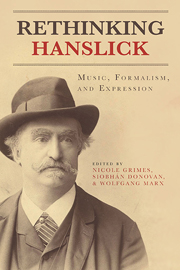Book contents
Introduction
Published online by Cambridge University Press: 05 July 2013
Summary
Eduard Hanslick is celebrated today primarily for his seminal publication in the field of music aesthetics—Vom Musikalisch-Schönen: Ein Beitrag zur Revision der Ästhetik der Tonkunst. Upon its initial publication in Leipzig in 1854, this small book elicited controversy and heated debate. The nine subsequent editions published throughout Hanslick's lifetime—between 1858 and 19021— ensured that the text remained the focus of debate on musical aesthetics well into the twentieth century.
Vom Musikalisch-Schönen, as Geoffrey Payzant reminds us, was directed against the aesthetics of feeling prevalent in eighteenth- and nineteenth-century writings on music, and sought to “clear away the rubble of obsolete prejudices and presuppositions” and to “mark out the foundations upon which a new theory might be built.” In writing his memoirs in the winter of his life, Hanslick acknowledged that the reception of the book was fraught with divisive reaction. He accepted some responsibility for this. Confronting directly the issue that had provoked the most controversy, and anticipating the concern that would continue to confound Hanslick scholarship, he conceded that it was misleading to speak of a “lack of content” (Inhaltslosigkeit) with regard to instrumental music. The fundamental issue he had tried to address was how musical form imbued with spirit (beseelte Form) was to be differentiated philosophically from empty form (leere Form).
- Type
- Chapter
- Information
- Rethinking HanslickMusic, Formalism, and Expression, pp. 1 - 12Publisher: Boydell & BrewerPrint publication year: 2013

